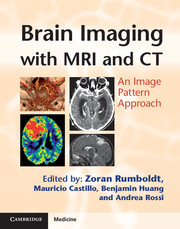Book contents
- Frontmatter
- Contents
- List of contributors
- List of abbreviations
- Preface
- Section 1 Bilateral Predominantly Symmetric Abnormalities
- Section 2 Sellar, Perisellar and Midline Lesions
- 38 Rathke's Cleft Cyst
- 39 Pituitary Microadenoma
- 40 Lymphocytic Hypophysitis
- 41 Pituitary Macroadenoma
- 42 Ectopic Posterior Pituitary Lobe
- 43 Langerhans Cell Histiocytosis
- 44 Craniopharyngioma
- 45 Hypothalamic Hamartoma
- 46 Optic Glioma
- 47 Perisellar Meningioma
- 48 Hemangioma of the Cavernous Sinus
- 49 Tolosa–Hunt Syndrome
- 50 Carotid-Cavernous Sinus Fistula
- 51 Perisellar Aneurysm
- 52 Chordoma
- 53 Chondrosarcoma
- 54 Colloid Cyst
- 55 Aqueductal Stenosis
- 56 Progressive Supranuclear Palsy (PSP)
- 57 Joubert Syndrome
- 58 Rhombencephalosynapsis
- 59 Multiple System Atrophy (MSA)
- 60 Maple Syrup Urine Disease (MSUD)
- 61 Chiari 2 Malformation
- 62 Tectal Glioma
- 63 Brainstem Glioma
- 64 Duret Hemorrhage
- 65 Hypertrophic Olivary Degeneration
- 66 Osmotic Myelinolysis
- 67 Germinoma
- 68 Pineoblastoma
- 69 Pineal Cyst
- 70 Vein of Galen Aneurysmal Malformation (VGAM)
- 71 Corpus Callosum Dysgenesis
- 72 Septo-Optic Dysplasia
- 73 Holoprosencephaly
- 74 Atretic Parietal Encephalocele
- 75 Dermoid Cyst
- 76 Lipoma
- Section 3 Parenchymal Defects or Abnormal Volume
- Section 4 Abnormalities Without Significant Mass Effect
- Section 5 Primarily Extra-Axial Focal Space-Occupying Lesions
- Section 6 Primarily Intra-Axial Masses
- Section 7 Intracranial Calcifications
- Index
- References
50 - Carotid-Cavernous Sinus Fistula
from Section 2 - Sellar, Perisellar and Midline Lesions
Published online by Cambridge University Press: 05 August 2013
- Frontmatter
- Contents
- List of contributors
- List of abbreviations
- Preface
- Section 1 Bilateral Predominantly Symmetric Abnormalities
- Section 2 Sellar, Perisellar and Midline Lesions
- 38 Rathke's Cleft Cyst
- 39 Pituitary Microadenoma
- 40 Lymphocytic Hypophysitis
- 41 Pituitary Macroadenoma
- 42 Ectopic Posterior Pituitary Lobe
- 43 Langerhans Cell Histiocytosis
- 44 Craniopharyngioma
- 45 Hypothalamic Hamartoma
- 46 Optic Glioma
- 47 Perisellar Meningioma
- 48 Hemangioma of the Cavernous Sinus
- 49 Tolosa–Hunt Syndrome
- 50 Carotid-Cavernous Sinus Fistula
- 51 Perisellar Aneurysm
- 52 Chordoma
- 53 Chondrosarcoma
- 54 Colloid Cyst
- 55 Aqueductal Stenosis
- 56 Progressive Supranuclear Palsy (PSP)
- 57 Joubert Syndrome
- 58 Rhombencephalosynapsis
- 59 Multiple System Atrophy (MSA)
- 60 Maple Syrup Urine Disease (MSUD)
- 61 Chiari 2 Malformation
- 62 Tectal Glioma
- 63 Brainstem Glioma
- 64 Duret Hemorrhage
- 65 Hypertrophic Olivary Degeneration
- 66 Osmotic Myelinolysis
- 67 Germinoma
- 68 Pineoblastoma
- 69 Pineal Cyst
- 70 Vein of Galen Aneurysmal Malformation (VGAM)
- 71 Corpus Callosum Dysgenesis
- 72 Septo-Optic Dysplasia
- 73 Holoprosencephaly
- 74 Atretic Parietal Encephalocele
- 75 Dermoid Cyst
- 76 Lipoma
- Section 3 Parenchymal Defects or Abnormal Volume
- Section 4 Abnormalities Without Significant Mass Effect
- Section 5 Primarily Extra-Axial Focal Space-Occupying Lesions
- Section 6 Primarily Intra-Axial Masses
- Section 7 Intracranial Calcifications
- Index
- References
Summary
Specific Imaging Findings
The cavernous sinus (CS) ipsilateral to the side of the carotid-cavernous sinus fistula (CCF) is typically enlarged with prominent contrast enhancement, and bilateral CS enlargement may be seen. T2-weighted MR images usually show abnormal flow voids within the CS, which may communicate with the cavernous internal carotid artery (ICA). Abnormal hyperintense flow is also present adjacent to the cavernous ICA on TOF MRA and the fistula site may be observed with other high resolution 3D MRI techniques and, usually to a better advantage, with CTA. Asymmetric and/or diminished pituitary gland enhancement may sometimes be observed. Additional imaging findings are primarily intraorbital: enlarged superior ophthalmic vein (SOV), thickened bulky extraocular muscles, proptosis, and intraorbital edema. Signs of intracranial venous congestion with engorged vessels and cerebral venous hypertension with white matter T2 hyperintensity may be present. Definite diagnosis is with cerebral DSA.
Pertinent Clinical Information
Most cases of CCF are post-traumatic, including rare iatrogenic causes (such as trans-sphenoidal surgery and Gasserian ganglion ablation). Based on the nature of the fistula, CCF is divided into direct and indirect types. Direct CCF is a high-flow lesion and the typical clinical presentation includes the triad of exophthalmos, bruit, and conjunctival chemosis. Diplopia (caused by ophthalmoplegia from compression of the cranial nerves), headache, retroorbital pain, development of glaucoma and decreasing visual acuity may be present in advanced cases. Indirect CCF is a dural arteriovenous fistula (DAVF) and may be of a low-flow or a high-flow variety.
- Type
- Chapter
- Information
- Brain Imaging with MRI and CTAn Image Pattern Approach, pp. 103 - 104Publisher: Cambridge University PressPrint publication year: 2012

